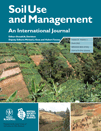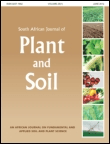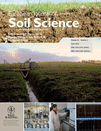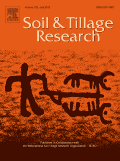
SOIL USE AND MANAGEMENT
Scope & Guideline
Advancing sustainable practices for soil health.
Introduction
Aims and Scopes
- Soil Health and Quality Assessment:
Research on indicators and methodologies for assessing soil health, including the impacts of various management practices on soil quality. - Sustainable Soil Management Practices:
Exploration of innovative soil management techniques that enhance sustainability in agricultural systems, focusing on practices like conservation tillage, organic amendments, and biochar application. - Soil Fertility and Nutrient Dynamics:
Studies investigating the effects of fertilizers (organic and inorganic), nutrient cycling, and management practices on soil fertility and crop yields. - Soil Carbon Dynamics and Sequestration:
Research on soil organic carbon storage, carbon sequestration strategies, and the role of land use changes in influencing carbon dynamics. - Soil Contamination and Remediation:
Investigation of soil contamination issues, including heavy metals and organic pollutants, and the effectiveness of various remediation techniques. - Soil Ecology and Microbial Dynamics:
Studies focusing on soil microbial communities, their roles in nutrient cycling, and how management practices affect soil biodiversity.
Trending and Emerging
- Climate Change Mitigation Strategies:
There is an increasing focus on how soil management practices can contribute to climate change mitigation, particularly through carbon sequestration and reducing greenhouse gas emissions. - Agroecological Approaches:
Emerging research emphasizes agroecology and regenerative practices that enhance soil health while improving productivity and ecosystem resilience. - Soil Microbial Interactions and Ecosystem Services:
A growing body of work is focusing on the role of soil microorganisms in nutrient cycling, soil structure, and overall ecosystem services, highlighting their importance in sustainable management. - Digital Soil Mapping and Precision Agriculture:
Advancements in technology have led to increased interest in digital soil mapping, remote sensing, and precision agriculture as tools for optimizing soil management. - Soil-Water Interaction Dynamics:
Research is increasingly exploring the interactions between soil properties and water dynamics, particularly in the context of irrigation management and drought resilience. - Waste Utilization in Soil Management:
There is a notable trend towards utilizing agricultural and organic wastes, such as biochar and composts, to improve soil fertility and health.
Declining or Waning
- Conventional Fertilizer Application:
Research related to traditional chemical fertilizer application methods is declining as interest shifts towards sustainable alternatives, such as organic amendments and integrated nutrient management. - Static Soil Management Approaches:
There has been a decrease in studies focusing on static or singular soil management practices, with a growing emphasis on dynamic, integrated approaches that consider the complexities of soil ecosystems. - Historical Soil Management Practices:
Research examining historical soil management practices is becoming less prominent, as the focus shifts towards contemporary practices that address current environmental challenges. - Soil Physicochemical Properties Alone:
While physicochemical properties remain important, studies focusing solely on these aspects without considering biological interactions are becoming less frequent.
Similar Journals

Biochar
Advancing Soil Health with Groundbreaking Biochar ResearchWelcome to Biochar, an esteemed academic journal dedicated to the exploration and advancement of biochar technology and its applications across multiple fields. Published by SPRINGER SINGAPORE PTE LTD, this journal serves as a vital platform for disseminating high-quality research that addresses the critical intersection of environmental science, soil health, and sustainable materials development. With a commendable Q1 ranking in the fields of Biomaterials, Environmental Science, Pollution, and Soil Science, Biochar is recognized for its significant impact, as evidenced by its placement in the upper percentiles across various Scopus rankings. Researchers and professionals in agricultural and biological sciences will find valuable insights and innovative methodologies that promote sustainable practices and enhance soil quality. This journal, operating from its base in Germany, is committed to fostering a collaborative environment where cutting-edge research can inform policy and practice. Engage with us as we strive to advance the science of biochar from 2019 to 2024 and beyond.

EURASIAN SOIL SCIENCE
Connecting global experts in soil science research.EURASIAN SOIL SCIENCE, published by PLEIADES PUBLISHING INC, is a premier journal dedicated to advancing knowledge in the fields of soil science and earth-surface processes. With an ISSN of 1064-2293 and an E-ISSN of 1556-195X, this journal has been a key resource for researchers and professionals from its inception in 1992 and continues to thrive as it converges toward 2024. Situated in the United States, EURASIAN SOIL SCIENCE has achieved notable recognition, attaining a Q2 ranking in both Earth-Surface Processes and Soil Science categories as of 2023. Its Scopus rankings further underscore its importance, with Earth and Planetary Sciences placing it at #81/179 and Agricultural and Biological Sciences ranking it at #80/159. Engaging a global audience, this journal publishes cutting-edge research articles, reviews, and case studies that address critical issues related to soil health, conservation, and management. Though currently not open access, the journal offers valuable insights and fosters collaboration among scientists and practitioners, underscoring its vital role in enhancing the understanding of soil dynamics and sustainability.

South African Journal of Plant and Soil
Empowering agricultural science through impactful studies.South African Journal of Plant and Soil is an esteemed academic publication dedicated to advancing the fields of Ecology, Plant Science, and Soil Science. Published by TAYLOR & FRANCIS LTD in the United Kingdom, this journal has been a vital resource since its inception in 1984, providing a platform for innovative research and scholarly articles that address critical issues in plant and soil management. With a current impact factor placing it in the Q3 category according to the 2023 rankings, it occupies an influential position within the academic community, especially amongst researchers focused on agricultural and environmental sciences. Although not an open-access journal, it remains accessible to a broad audience through libraries and institutions that recognize its value in facilitating ecologically and environmentally focused discussions. The journal's ongoing commitment to publishing high-quality research ensures that it plays a pivotal role in nurturing knowledge and fostering advancements in sustainable practices across southern Africa and beyond.

Soil Systems
Championing Open Access Research in Soil SystemsSoil Systems, published by MDPI, is a premier open access journal dedicated to advancing the understanding of soil science and earth-surface processes. Launched in 2017, this journal has quickly established itself with a strong presence in the academic community, holding a prestigious Q1 ranking in both Earth-Surface Processes and Soil Science as of 2023. With an impressive Scopus rank in the top 20% of its categories, Soil Systems is an essential platform for disseminating groundbreaking research addressing the challenges and complexities of soil management, its ecological significance, and its role in sustainable development. The journal operates under an open access model since 2018, ensuring maximum visibility and accessibility for researchers, professionals, and students alike. Based in Switzerland, at ST ALBAN-ANLAGE 66, CH-4052 BASEL, Soil Systems encourages contributions that promote interdisciplinary collaboration, innovative methodologies, and the application of findings to real-world issues related to soil health and environmental sustainability.

EUROPEAN JOURNAL OF SOIL SCIENCE
Uncovering Solutions for Soil SustainabilityEUROPEAN JOURNAL OF SOIL SCIENCE, published by Wiley, stands as a leading platform in the field of soil science, recognized for its contributions to the understanding of soil ecology, management, and sustainability. With an impressive impact factor and a distinguished Q1 ranking in Soil Science, this journal has recently ranked 23rd out of 159 in its category on Scopus, placing it in the 85th percentile among its peers. Covering a wide array of topics as it converges into the future, from 1994 to 2024, the journal aims to disseminate groundbreaking research and innovative methodologies that address the pressing challenges of soil degradation and environmental sustainability in Europe and beyond. Although it is not an open access journal, the EUROPEAN JOURNAL OF SOIL SCIENCE remains a vital resource for researchers, professionals, and students seeking to deepen their understanding and explore the latest advancements in soil science.

SOIL & TILLAGE RESEARCH
Unveiling the Secrets Beneath Our FeetSOIL & TILLAGE RESEARCH is a premier international journal dedicated to advancing the understanding of soil science and tillage practices through high-quality research and insightful reviews. Published by Elsevier and based in the Netherlands, this esteemed journal boasts impressive impact metrics, being ranked in the Q1 category across multiple domains including Agronomy and Crop Science, Earth-Surface Processes, and Soil Science, reflecting its pivotal role in the academic community. With an H-Index that underscores its citation impact and a Scopus ranking placing it in the top percentiles of its field, SOIL & TILLAGE RESEARCH serves as a vital resource for researchers and professionals focusing on sustainable agricultural practices, soil management, and environmental conservation. This journal provides a platform for open dialogue and dissemination of knowledge that shapes future research directions and policy-making in land use and sustainable agriculture.

SOIL SCIENCE SOCIETY OF AMERICA JOURNAL
Pioneering Knowledge in Soil Science Since 1976Welcome to the SOIL SCIENCE SOCIETY OF AMERICA JOURNAL, a premier publication in the field of soil science, published by WILEY. With a distinguished history dating back to 1976, this journal has consistently provided a platform for researchers to share innovative findings and insights into soil’s critical role in agricultural and ecological systems. Featuring an impressive Q1 category ranking in Soil Science and positioned within the top 25% of its field according to Scopus, this journal is recognized for its impactful contributions to advancing our understanding of soil dynamics. While not an open-access journal, it remains a valuable resource for academics and professionals alike, with distinguished articles that meet the highest scientific standards. As it enters its converged years from 1976 to 2024, the journal aims to continue shaping the future of soil research, offering valuable knowledge to students, researchers, and practitioners dedicated to sustainable land management and environmental preservation.

Soil Research
Innovating solutions for soil and environmental challenges.Soil Research, published by CSIRO PUBLISHING, is an esteemed scholarly journal dedicated to advancing the field of soil science, environmental science, and earth-surface processes. With an ISSN of 1838-675X and E-ISSN of 1838-6768, this journal serves as a vital platform for researchers and professionals to disseminate innovative findings and engage with contemporary challenges in soil and environmental management. The journal is recognized for its impactful contributions, as evidenced by its Q2 ranking in 2023 across multiple categories including Earth-Surface Processes, Environmental Science, and Soil Science, reflecting its influence and relevance in these critical academic areas. Operating from its headquarters in Clayton, Victoria, Australia, Soil Research is committed to fostering open access to research, ensuring wider dissemination of knowledge. As it converges toward its future objectives until 2024, the journal aims to provide a forum for diverse perspectives that enhance understanding and stewardship of soil resources, making it an indispensable resource for students, researchers, and industry professionals alike.

Spanish Journal of Soil Science
Connecting Scientists to Transform Soil ScienceThe Spanish Journal of Soil Science is a prestigious open-access journal published by FRONTIERS MEDIA SA since 2011. Based in Switzerland, this journal serves as a vital platform for disseminating innovative research and applications within the field of soil science. With its commitment to accessibility, the journal enables researchers, professionals, and students from around the globe to contribute to and benefit from its wealth of knowledge. As of 2023, it holds a respectable Q3 category ranking in soil science and is positioned at #88 out of 159 in the Scopus rankings for Agricultural and Biological Sciences. The journal aspires to foster collaboration and communication among soil scientists, encouraging the exploration of contemporary soil issues, sustainable practices, and advancements in technology. Its open-access model ensures that the latest findings are freely available, promoting a broader impact in environmental and ecological studies.

PLANT SOIL AND ENVIRONMENT
Fostering Global Dialogue on Soil and Environmental Science.PLANT SOIL AND ENVIRONMENT is a premier open-access journal dedicated to the interdisciplinary study of soil science, agronomy, and environmental interactions, published by the Czech Academy Agricultural Sciences. With an ISSN of 1214-1178 and E-ISSN 1805-9368, this journal has been a vital platform for dissemination of research since its inception in 2002. Based in the Czech Republic, it has garnered a robust reputation within its field, as indicated by its impressive Q2 ranking in Soil Science and ranking #47 out of 159 in the Scopus Ranks for Agricultural and Biological Sciences, placing it in the 70th percentile overall. The journal explores diverse topics within soils and their significant roles in plant health, ecosystem services, and sustainable agricultural practices, contributing important insights that benefit researchers, practitioners, and policy-makers alike. Aiming for a global outreach, PLANT SOIL AND ENVIRONMENT not only facilitates open dialogue among scientists but also ensures that cutting-edge research is freely accessible to enhance the knowledge base in soil science.